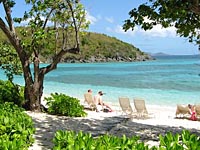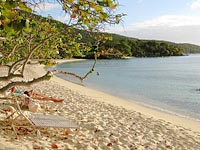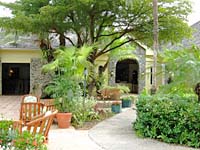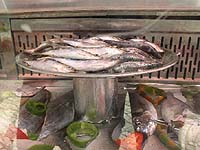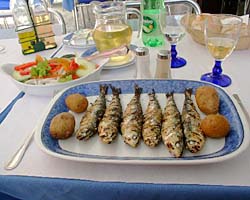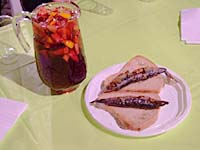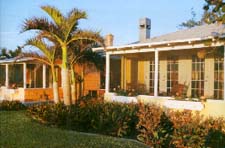Le Tour de France: Lance Armstrong Rides to Victory
After landing in Paris we took the convenient Roissey bus into the city. Disembarking at the magnificent Opera House, we headed for the Ambassador Hotel, a member of the Concorde Group (see Hotel Spotlight). Rolling our suitcases along the Boulevard Haussmann, named after the architect of Paris -- admiring its architecture, wrought iron terraces and huge wooden doors -- we were also distracted by the magnetic attraction of the new fall fashion display at the Galleries Lafayette. We promised ourselves a visit later.
Arriving in Paris the day before the final lap of the Tour de France, our overriding goal was to find the best spot to watch American hero Lance Armstrong ride down the Champs Elysees on Sunday afternoon.
The next morning, fighting off jet lag, Diana and I found our way to an excellent spot on the sidewalk at Champs- Elysees, with a clear view down the wide boulevard to the ferris wheel at the Place de la Concorde.
The air was filled with a lively suspense. Spanish fans waving flags and chanting 'Viva Espana' were being shouted down by flag-waving Italians on the other side of the wide avenue. American flags were well represented, even by those who appeared to be French. According to a Le Monde report, Lance Armstrong was asked about the hordes of fans carrying American flags along the route.
'Many times you get next to them, and it's a French person. It's strange, but it happens. I can't complain about that kind of support, it's very much appreciated.'
He had spoken often about the need to repair the strained relationship between the US and France. Armstrong is a winner on two levels, as both a champion cyclist and a valiant survivor of cancer who has brought even more interest to the Tour and who appears to have won the hearts of the French. The most common description you hear is, 'Un grand monsieur,' a class act, and they say if he wins, he deserves it.
Advertisers sailed by on floats, the Smart Car rolled by in every color imaginable. There is a long wait, followed by the loud sputtering of police on motorcycles scanning the crowd on both sides of the avenue. Shortly afterwards they came like a swarm of bees together, riding silently, as though on air, helmets disguising their individuality. They were all there, in a tight group, and in the middle rode the hero, Lance Armstrong, distinguishable in his yellow shirt. The crowd cheered with enthusiasm and in seconds they were gone. But nobody minded waiting to catch another glimpse when they came around again in 20 minutes. The sun beamed down and all seemed right with the world.
Later, festivities continued at the Arc de Triomphe with billowing clouds of play smoke, yellow representing the winner, punctuated by bursts of pinks and blues. Gyrating gymnasts jumping, twirling and dancing to live music. Cyclists showing every imaginable and daring possibility between rider and bicycle. Ah, Paris is the place to be tonight!
Losing the Eiffel Tower
Later that evening, in our hotel hopping enterprise among the Concorde Hotels, (two days in each of their three finest hotels), we moved from The Ambassador to the Lutetia on the Left Bank. (See more in Hotel Spotlight).
Walking into our room at the Lutetia, Diana and I were blown away by the sight of the Eiffel Tower framed in our window. We saw it alight with its post-millennium sparkles, a dancing mass of white stars flowing up and down. Dropping our suitcases in a corner, we decided we couldn't retire for the night until we walked to the Eiffel Tower. It was a greater distance than we had reckoned. Walking in the general direction of the tower, down narrow streets with hardly a person around, we kept losing it behind high buildings. We stopped friendly gendarmes with little round hats to explain our plight. They took maps from back pockets and explained they were only in town for the Tour de France and didn't know Paris. When we finally reached the famous tower, we fell, exhausted, onto the park lawn beneath what looked like a gigantic erector set. We lay there taking time to study the genius of the myriad of interweaving iron, softened by thousands of lights.
The Eiffel Tower was built in 1889 in preparation for the World's Fair. It was designed by Gustave Eiffel who also designed the complex structure of the Statue of Liberty. This world wide symbol of France was not meant to be permanent. Constructed like a large pylor, 300 meters high, with four columns of lattice work, it is separated at the wide base and comes together at the narrow top. Although it is airy and wind resistant, this can also make it quite cold when you wait for the second elevator, half way up, on a cool windy day. On this lovely summer evening we stayed, hypnotized by the lights, until after midnight. Looking around, it could have been late afternoon, we watched people milling about in an aura of great tranquillity. Yes, Paris is the place to be tonight.
George Bush and Mona Lisa
I love Leonardo da Vinci's painting of the Mona Lisa, circa 1503. But the first time I saw it was right out of high school when I was too young to fully appreciate it. Standing in front of the world famous painting then, I could only wonder what all the fuss was about.
Years later, having gained some understanding of the difficulty in becoming a good artist, much less great artist, and having traversed life's vicissitudes as a woman, I stood in front of the painting once again, and was stirred deeply, to the point of tears. She seemed to look at me with a mind of her own. How could the artist create anything so enigmatic? Every time I looked back at her, the expression seemed to change. Was she smiling? I actually felt goose bumps. She is virtually alive! I knew now what all the fuss is about.
Da Vinci is said to have loved the painting so much that he had carried it with him everywhere, until eventually in France, he sold it to Francis I.
Looking around, I wondered if anyone else was so touched. Without making any judgements, this time I decided to conduct a few interviews to hear what people thought about the Mona Lisa. So with pen and paper, I approached a few visitors to the Louvre and tried to keep my question simple, asking if the Mona Lisa had lived up to their expectations, or were they disappointed. In conducting these interviews, I received far more information then I had anticipated.
'Much smaller than I expected,' commented a young man from Arizona who was waiting for the crowd to disperse for a better view.
'There are hundreds of paintings in this museum just as good. In fact,' said an Englishman with his wife by his side, 'Many of da Vinci's other paintings are better than this one. Rumors spread, people hear about the Mona Lisa, and they come here to the Louvre just to see this one painting.'
'It's too green, too dark; she is quite pretty, but not that exciting,' his wife interrupts, pulling him along.
'I was expecting something larger,' says a tall, young blonde from Hungary, walking with her girlfriend. Then with a laugh and a swish of ponytail, she adds, 'The Mona Lisa is not sexy, not attractive, and in my opinion the whole painting needs more color.' Her friend agrees, and they move on.
A woman from Texas, Anne, and her teenage son, Derek, stopped by. 'I really like the eyes on this painting, you can stand anywhere in the room and they follow you. She looks like the Madonna. I think you are the only American I have met in Paris,' said Anne.
She continued, 'You know when I told one of my neighbors I was going to Paris, she told me she was boycotting France. Her friends are too. I can't believe what is happening in America. I think we are acting foolishly. We need a different President with a different attitude, we need to study our place in the world and not get into expansionism.'
'Whoops,' I thought, this is not quite the direction I wanted to take with the interview.
Endeavoring to get back on track, Anne looked again at the painting. The crowd was dense, it was becoming hot and sticky in the Louvre, and although she was smiling, she responded a little wearily.
'Actually I think this painting is overrated. I know it's supposed to be great, but I can't see it.'
'I agree with the Dixie Chicks,' said her son, clearly uninterested in talking about the painting. 'But look what happened to them.'
'We are heading toward McCarthyism,' said Anne, animated again. 'We are living in a democracy, but you can't actually speak your mind. Nine eleven was terrible, but now we are going to extremes rounding up innocent people. Ashcroft is too much. It's a scary thing, but I'm glad I came to France.'
Anne and Derek said goodbye and moved on, but just before disappearing in the crowd, she shouted back, 'You probably won't see any more Americans here.'
A young girl, Sima, from Israel, smiled and offered her opinion. 'I don't know much about the painting, it seems well balanced and I like how her eyes follow you,' she said softly.
'How are you enjoying Paris?' I couldn't help asking.
'I love being in Paris. Things are good in Israel right now, (July 31), but all it will take is one explosion, one bomb, and everything will come down again.'
The crowd cleared for a moment and a Japanese girl wearing a wide, flared skirt, swirled next to the painting, while her boyfriend took her photo. 'Now look at her,' said an Englishman at my elbow, pointing his chin at the smiling Japanese girl. 'She thinks she is better than the Mona Lisa.'
'It's the smile that made it so famous, isn't it?' said his wife, continuing to ponder the painting. 'It's the known factor, isn't it?' she went on. 'I don't know what is behind that smile, but I'm English. We noticed those Italian women over there; they all want their photos taken with the Mona Lisa. They probably know more about the painting than we do.'
The Italian ladies group, art aficionados, told me they did not like being with so many other visitors. 'The Mona Lisa is just an emblem for tourists,' said one of them, rolling her eyes. 'I don't know if people come just because of the media attention or because they really like art.' She leaned forward to whisper, 'There are too many tourists here. It doesn't even smell so good. The museum should program the entrance so that people have more time to really see the Mona Lisa.'
'She not only looks serene, she is serene,' said another emphatically. 'It's the way we all want to be,' said another. They all nodded their heads in agreement.
I don't know what Leonardo, the universal genius, who ushered in the art of the High Renaissance, would have to say about all this, but he probably was quite accustomed and oblivious to it all.
Parisian Evenings to Remember
A visit to the famous Moulin Rouge, a magnet for tourists, should not be missed if you enjoy cabaret. The Montmartre cabaret club opened in 1889 and was immortalized by painter Henri deToulouse –Lautrec. A parade of international stars have performed there including Edith Piaf, Maurice Chevalier, Frank Sinatra, Liza Minelli, and Elton John.
Tonight it's the razzle dazzle of the Ferrie, a troupe with over 100 artists and the 60 dancing Doriss Girls doing the fabulous Can Can. Bursting with infectious energy, it was easy for the audience to get swept up in with the talented, topless dancers decked out in thousands of feathers, sequins, rhinestones and net stockings, and wearing the perfect dancing shoes -- spiked heels. According to a press release, the girls all have to be 5 foot 8 and have astounding figures that will leave the audience spellbound!
The orchestra was fantastic, the audience was attentive and the bottles of champagne, on every table, added to the bubbling exuberance of it all.
Flying Over the Edge
A visit to the Jardin des Tuileries and the amusement park at night offers the child inside an opportunity to burst free and enjoy the frothy side of Paris. The Ferris wheel makes a half turn and stops. I am suspended over Paris. I can see it all -- towers, domes, chimneys, the Obelisk and all the rooftops of Paris. Then I am spun faster and faster, counterclockwise in a rainbow of pastel lights towards the heavens where a sliver of new moon has just appeared. I am spinning to earth again, skimming a carpet of Parisian lights. Around and around, I am spun in circles of light. My heart sings, 'Ah, Paris is the place to be tonight.'
Flinging caution to the wind, Diana and I decide to ride the bumper cars. One glance at the clientele, hyperactive, rowdy boys, should have discouraged me, but we bought two tickets and jumped in. Yes, we laughed, as we dashed and ducked defensively, but the laugh didn't last long. They suddenly descended on us -- the wild boys! We spun and pitched and got clobbered so badly that the Boss came by in his car to break up the melee and free us again for travel.
Walking away, a bit wobbly from that mildly traumatic experience, we watched a girl with a blue balloon, sailing high above us in the swinging chairs. Stretching her arms out, hair sweeping behind, one could sense her delight: she is flying, and she knows it!
We pause awhile to watch the tiny children riding a merry-go-round. One little girl, her bottom lip trembling, holds on with two hands to the head of a huge yellow duck. Another girl, riding a long-necked giraffe, has one hand out catching the wind. We hear screams coming from the Ejector where a crowd is shouting, 'Come on USA.' A couple of young men have just landed and are unfastening their seat belts. They walk toward the crowd, a bit weak-kneed, heads down. Then two brave, young lassies strap themselves in. We headed back to our hotel as they were lifted 30 feet in the air and tumbled upside down.
A Visit to the Palace of Versailles
We took the RER from the Hotel Lutetia to the Royal Palace of Versailles and walked to the main entrance. I had dreamed of it once, but in the dream the beautiful, immense wrought iron gates were closed, I could't get in. Today they're wide open, and the first sight of the palace is breathtaking. It is the most famous garden-palace combination in Europe, possibly the world. It marks the flowering of the era of French baroque. The museum is known as the centerpiece of the empire of the Sun King, Louis XIV, and inside, immortalized, we see his portrait everywhere.
Originally built as a hunting lodge for members of royalty, it lies within 45minutes travel distance from the cultural capital of Paris. It was constructed at the dawn of the 17th century. Around the 1680's, King Louis moved the base of the French monarchy from Paris to Versailles. After the French revolution (1789-1799), which terminated the reign of Louis XVI, all the furnishings and decor were sold and the palace was converted into a museum.
Along with the immense art collection and some original antiques, the Hall of Mirrors made me gasp when I stepped in. The hall remains as it was in royal times. As in the observation and appreciation of the Mona Lisa at the Louvre, to really feel the ambience, to get a true sense of the space and the reflections from the mirrors, one would like to be here almost alone. However, even with the crowd of tourists, it was impressive.
Although it was raining outside, from the windows, Diana and I could see and admire the vastness and beauty of the elaborate gardens adorned with a myriad of monuments and graceful sculptures.
Sacre Coeur and the Artists of Montmartre
We moved from the Lutetia to the beautiful Hotel Du Louvre, and were thrilled to find ourselves in a most unique setting, our room was scarlet and our windows overlooked the quadrangle of the Musee Louvre (see Hotel Spotlight). Becoming accustomed to using the Metro, we took it out to Montmartre and walked through its charming, winding streets filled with boutiques, restaurants and art galleries. We climbed the long way up the steps to the white Roman-Byzantine cupolas of the Sacre-Coeur, and as I stood on the top step and looked at the white dome and towers, it reminded me of the Taj Mahal.
The church was built between 1875 and 1914 as atonement for the massacred victims of the 1871 Franco-Prussian War. It was the dream of two Catholic businessmen, Alexandre Legentil and Rohault de Fleury, who made a vow, at the outbreak of the Prussian War, to build a church to honor the Sacred Heart of Jesus. Just as the Sacre Coeur was completed, the Germans invaded and it wasn't consecrated until 1919, after World War I.
The area around the church is also the site of at least 100 working artists, whom some call fake artists. But many are really good at portraiture and have some excellent oil paintings of the church for sale. The artists seemed a little hungry for business this year. One long-haired artist pulled a reluctant golden Spaniel onto his lap, and when I held up my camera for a photo, he shouted gruffly, 'You pay me!' Diana sat for a charcoal portrait, but the result was overworked and unprofessional.
Paris Moonlight, Bridges and La Plage along the Seine
On our last evening in Paris we met Sophie, our Parisian friend, aboard the new, restaurant boat Planet sur Seine, docked at the Invalides Bridge along the Seine. The owner decided that Parisians needed a fun place to go and dine during the month of August, when most have left on holidays. Guests were milling about the bar, in casual elegance, sipping champagne. Oriental rugs were spread across the deck, and the fading light was just beginning to splash shadows along the river. From my deck position, I had a wonderful view of Les Invalides, the most impressively scaled monument of the Rive Gauche. It was built under Louis XIV as a hospital to house 6,000 invalid soldiers. I could see the huge golden dome of the Eglise du Dome, where some of France's greatest soldiers are entombed including Emperor Napoleon I. These historic buildings along the Seine, looked their best in the last hush of evening -- shimmering, regal and magnificent. Standing in that peaceful moment of beauty, I wondered who could resist the magic of Paris, at its best on a sultry, summer evening. Lines from a Wordsworth poem came to me:
Ships, towers, domes, theaters and temples lie open to the fields and to the sky…. Dull would he be of soul who could pass by a sight so touching in its majesty.
The poet was speaking of London, of course, but Paris has a playful magic that London can't replicate.
Just before sunset, we left the ship and set out to explore the ever-lively world of Paris below the bridges. We wanted to find the Paris Plage, a unique, riverfront beach environment, complete with beach sand and palm trees, created a year ago by Bertrand Delanoe, the new mayor
We walked along the right bank from Les Invalides all the way to Notre Dame. As the evening slowly transitioned from light to dark, an even more spectacular view of Paris emerged along the banks of the Seine. We admired the amazing variety of architectural wonders lined up on the opposite bank -- the Musee D'Orsey, the Conciergerie, (the first prison in Paris), the Institute de Paris, the Assemblee Nationale, (currently housing an interesting woman's exhibit:'Mariannes of Today). Palais de Justice, and Sainte Chapelle. At one point we stopped and looked behind us at a spellbinding scene -- the curve of a bridge with several bridges in the background, the historic buildings, the boats and barges moving slowly along the water, all touched by the bright light of a strong, crescent shaped moon.
Further along, after walking beneath a bridge lit up in psychedelic blue, we arrived at La Plage. The scene changed again. A narrow embankment of sand runs alongside a promenade dotted with palm trees. The edge of the river is flanked by flags, flapping like sails in the breeze. There are showers where people can cool off when the sun is hot, without being tempted to jump into the Seine. We see a variety of picnic styles, from a wrapped sandwich, to a white tablecloth spread out with wine glasses. Catching the romantic aura of the night, a gray haired couple spontaneously stop -- pour un baiser. Everything is low key, tranquil, people talk quietly, a few have guitars, another group plays chess. We come to a small crowd standing around a young, svelte, blonde girl. Like a ballet dancer, she is whirling two ropes of fire around her body, in perfect balance, yet dangerous enough to make the crowd flinch before they erupt in applause. Ah, Paris is the place to be tonight.
Our long walk finally ended at the city's most beautiful cathedral, Notre Dame, and at the point of starvation. Considered one of the greatest achievements in Gothic architecture, it is especially inspiring in the evening light. Designed by Maurice de Sully, and built between 1163 and 1345, its massive interior can accommodate over 6000 people.
Almost exhausted, we walked from Ile de la Cite, across the Seine, to the left bank and the St. Germain array of ethnic restaurants. The variety of food possibilities in the window of a Greek restaurant led to our ordering a full banquet of shish kabob consisting of huge salmon chunks, shrimp, tomatoes, onions, aubergine, and potatoes, along with a bottle of French bordeaux.
We danced, and broke plates and wished that we could continue discovering and exploring every corner of Paris. Sophie toasted to our next visit, which could not come soon enough. Diana and I toasted all the great French people we had met, and to all the strangers in the streets who showed the utmost kindness and patience when we asked directions or practiced our meager French language skills. We added a special toast for all those Americans (50% dropoff) who had missed a chance to truly experience the joie de vivre of Paris, and hoped they would feel free to return again in the springtime.




